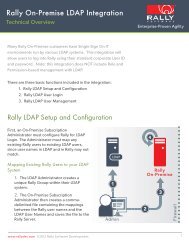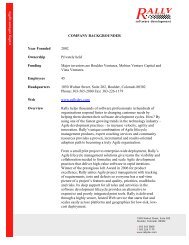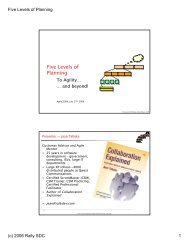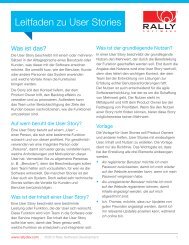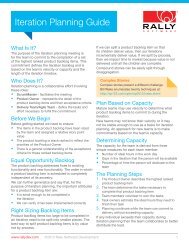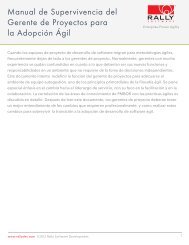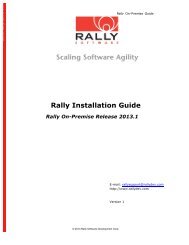A CIO's Playbook for Adopting the Scrum Method of ... - Rally Software
A CIO's Playbook for Adopting the Scrum Method of ... - Rally Software
A CIO's Playbook for Adopting the Scrum Method of ... - Rally Software
You also want an ePaper? Increase the reach of your titles
YUMPU automatically turns print PDFs into web optimized ePapers that Google loves.
Description: Organizational change projects within various departments drive out emerging andchanging impediments.Assess and AdaptDuration: Every SprintSupport: External / Internal <strong>Scrum</strong>MasterDescription: Review qualitative and quantitative metrics. Add additional metrics and review captureprocesses whenever a surprise has occurred.Play 4 - Measure, Assess and AdjustThe objective <strong>of</strong> this play is to assess <strong>the</strong> organization’s progress and to establish a broader set <strong>of</strong> metrics toserve as a basis <strong>for</strong> fur<strong>the</strong>r expansion. The CIO should be aware that <strong>the</strong> upcoming discussion <strong>of</strong> metricsmay be both controversial and entertaining as many <strong>of</strong> <strong>the</strong> traditional metrics that might be in place prior to<strong>Scrum</strong> adoption (example: measures <strong>of</strong> “document completeness”) are no longer relevant. Fortunately,<strong>Scrum</strong> and agile practices are indeed accountable and measurable and practitioners are converging on a set<strong>of</strong> metrics that provide qualitative and quantitative feedback at both <strong>the</strong> process and project level.But be<strong>for</strong>e entering this discussion, a key distinction needs to be made between many traditional s<strong>of</strong>twaredevelopment processes and <strong>Scrum</strong> and agile:The primary metric <strong>for</strong> agile s<strong>of</strong>tware development is whe<strong>the</strong>r or not working s<strong>of</strong>tware actually exists,and is demonstrably suitable <strong>for</strong> use in its intended purpose. In <strong>Scrum</strong>, that key indicator isdetermined empirically, by demonstration, at <strong>the</strong> end <strong>of</strong> every single Sprint.This primary measure <strong>of</strong> s<strong>of</strong>tware quality and productivity is <strong>the</strong> essence <strong>of</strong> agile development. So with<strong>Scrum</strong>, you cannot be very far <strong>of</strong>f your objective without knowing that you are. All o<strong>the</strong>r metrics aresubordinate to that objective and its constant mantra <strong>of</strong> “delivering working s<strong>of</strong>tware more frequently”.At this point in <strong>the</strong> <strong>Scrum</strong> adoption game, a significant part <strong>of</strong> <strong>the</strong> organization is now operating in an agilemanner. Sprint results <strong>of</strong> <strong>the</strong> initial projects are <strong>the</strong> primary measure <strong>of</strong> <strong>the</strong> effectiveness <strong>of</strong> <strong>the</strong> new teambehaviors and <strong>the</strong>ir new processes. This data should be published and analyzed.Moreover, now is <strong>the</strong> appropriate time to define a set <strong>of</strong> secondary metrics used to guide your organizationon how it implements <strong>Scrum</strong>. In so doing, <strong>the</strong>re are two types <strong>of</strong> metrics that may be applied:Process Metrics – primarily qualitative indicators on <strong>the</strong> effectiveness <strong>of</strong> <strong>the</strong> teams and organizationin adopting <strong>Scrum</strong>. These include items such as effectiveness <strong>of</strong> <strong>the</strong> teams in managing <strong>the</strong> ProductBacklog, effectiveness <strong>of</strong> <strong>Scrum</strong> processes such as <strong>the</strong> <strong>Scrum</strong> daily meeting, Sprint Planningmeeting, etc. In cooperation with <strong>the</strong> <strong>Scrum</strong>Alliance, Hartman and Stallings have developed atemplate <strong>of</strong> process metrics that can be used by any organization that is implementing <strong>Scrum</strong>. Thesemetrics appear as Table 1 in Appendix 2.Project Metrics – At <strong>the</strong> project level, an additional set <strong>of</strong> metrics may be applied to measure <strong>the</strong>results <strong>for</strong> a particular <strong>Scrum</strong> team and <strong>the</strong> service, component or system that <strong>the</strong>y are accountable<strong>for</strong>. These may include some traditional metrics such as defect count, percentage <strong>of</strong> code with unittest coverage, percentage <strong>of</strong> code covered by automated regression tests, etc., as well as <strong>Scrum</strong>specific metrics such as number <strong>of</strong> user stories finished and demonstrable at <strong>the</strong> end <strong>of</strong> each Sprint.An example set <strong>of</strong> <strong>the</strong>se metrics appears as Table 2 in Appendix 2.A Note on Quality and <strong>Scrum</strong>Customers <strong>of</strong>ten pressure development organizations to deliver features faster than is feasible. Someorganizations accommodate this by reducing <strong>the</strong> quality <strong>of</strong> <strong>the</strong> product, dropping re-factoring, cutting testef<strong>for</strong>ts and o<strong>the</strong>r solid engineering practices. This is not supportable within <strong>Scrum</strong> practices since <strong>the</strong> systemor product is a corporate asset, refined continuously and objectively measured, not a one-time project asset.Engineering organizations that succumb to this pressure eventually build “design dead” systems that can notbe effectively maintained or enhanced. The organization suffers <strong>the</strong> huge cost <strong>of</strong> a substantial rewrite and re-© 2005 <strong>Rally</strong> S<strong>of</strong>tware Development Corp., Ken Schwaber and <strong>Scrum</strong>Alliance 13



